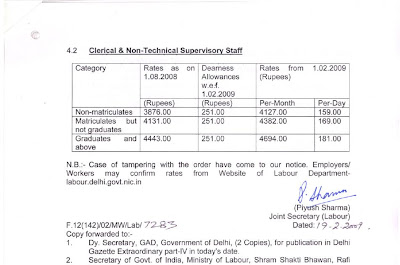| Will the Minister of | SCIENCE AND TECHNOLOGY | be pleased to state:- |
(a) whether the CSIR has been taken into consideration the modifications and clarifications made by the Government in the date of adoption of the scheme granting Non-functional pay scale of Rs. 8000-13500 to the Section Officers; (b) if so, the details of implementation of the scheme by CSIR; (c) whether the said scheme is not being implemented in accordance with the approvals granted by the Government; (d) if so, the reaction of the Government thereto and the steps being taken to ensure proper implementation of the scheme by CSIR; (e) whether any complaints have been received by the Government regarding tardy i mplementation of the Scheme and against the spirit of the Government approvals thereto; (f) if so, the details thereof; and (g) if not, the time by which the scheme is likely to be implemented ? |
| ANSWER |
MINISTER OF SCIENCE AND TECHNOLOGY AND MINISTER OF EARTH SCIENCES (KAPIL SIBAL) (a) No Sir, as the scheme formulated by Department of Personnel and Training was specific to Section Officers of Central Secretariat Services, Ministry of Finance, Department of Expenditure did not agree to extend it. (b) The Non Functional Scale of Rs 8000-13500 was implemented in respect of Section Officers w.e.f. 03.10.2003, based on the approval given by the Governing Body of CSIR in its 166th meeting held on 16.02.2006 and the decision dated 17.05.2007. (c) Ministry of Finance, Department of Expenditure, did not agree to extend Non Functional Scale to the CSIR as the scheme was specifically formulated by Department of Personnel and Training for Section Officers of Central Secretariat Services. (d) The issue regarding grant of Non Functional Scale to the Section Officers was taken up with Ministry of Finance, Department of Expenditure both formally and informally and it was not agreed to by the Government. (e & f) Yes Sir. Representations from the employees and references from Director Central Institute of Medicinal & Aromatic Plants (CIMAP), Lucknow and Hon’ble Members of Parliament were received for implementing the Non Functional Scale of Rs 8000-13500 notionally from 1.1.1996 with actual benefit from 3.10.2003. Details of same are given in Annexure I. (g) In view of the observations of Ministry of Finance, Department of Expenditure, Non Functional Scale of Rs 8000-13500 could not be extended notionally wef 01.01.1996. |






















